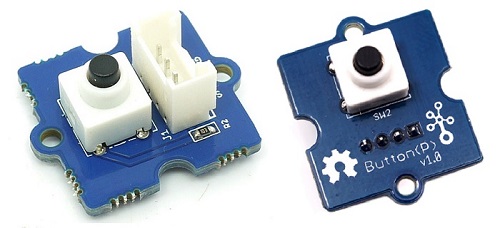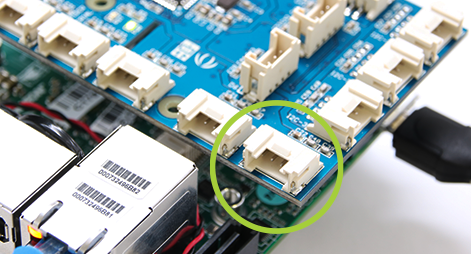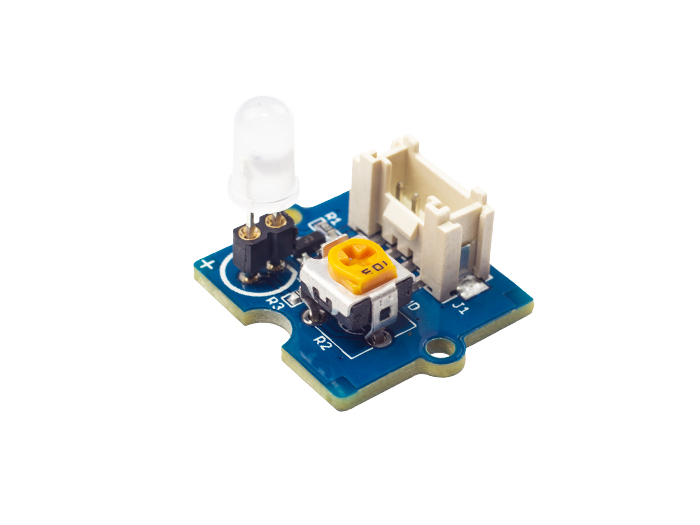Introduction to Digital GPIO
The lab guides you through the creation of four programs using combinations of input and output and the Arduino and MRAA APIs.
| I/O | API |
|---|---|
| Digital Input | Arduino API |
| Digital Output | Arduino API |
| Digital Input | MRAA API |
| Digital Output | MRAA API |
MRAA API vs. Arduino API
Both the MRAA and Arduino APIs are available in the Arduino Create environment and you can choose which to use, but why are there two APIs to program sensors and actuators? To answer this let’s list of the pros and cons of using each set of APIs?
The Arduino APIs are simple, widely used by developers and the Arduino Development environment will let the developer use them on any Arduino board. Sounds pretty good. However, if you would like the program to be portable to Raspberry Pi or Intel NUC, or if you needs access to low level APIs calls while maintaining that portability then the MRAA APIs are useful. In a later lab we will demonstrate the UPM APIs which are both portable and high level.
Lastly, when you are using the Arduino Create environment with an Intel IoT board, you should know that the Arduino APIs are actually rewritten using the MRAA API. The Arduino group has done this so that there APIs can take advantage of the portability that MRAA provides.
Digital Input using the Arduino APIs
Hardware
| Sensor | Pin |
|---|---|
| Grove Button | D4 |
The Grove button

Look for port D4 and connect the buttonState

Software
First define a constant to hold the GPIO pin that the LED uses. The Up2 board uses a SUBPLATFORM_OFFSET of 512. The offset needs to be added to the all the PIN numbers used in the program.
// Digital Input Sensor should be plugged into D4
#define PLATFORM_OFFSET 512
#define PIN 4 + PLATFORM_OFFSET
Next define the setup() function. It will run once at the beginning of the program’s execution.
// the setup routine runs once at the beginning of the program
void setup() {
// Set the subplatform for the Up2 board
mraa_add_subplatform(MRAA_GROVEPI, "0");
// initialize serial communication at 115200 bits per second:
DebugSerial.begin(115200);
// make the pushbutton's pin an input:
pinMode(PIN, INPUT);
}
Lastly, the loop() function will run continuously as long as the program is executing/
// the loop routine runs over and over again forever
void loop() {
// read the input pin:
int buttonState = digitalRead(PIN);
// print out the state of the button to the SerialMonitor
DebugSerial.println(buttonState);
// delay in between reads for stability
delay(1);
}
Run the Program in the Arduino Create environment
Now run the final program in the Arduino Create environment.
https://create.arduino.cc/editor/danielholmlund/ef578e57-c2d4-46f6-a653-fe396dd38110/preview
Digital Output using the Arduino APIs
Hardware
| Sensor | Pin |
|---|---|
| Grove LED | D4 |
 The digital output program follow the same with the exception that the PIN is an OUTPUT rather than an INPUT and the digitalWrite() function is used rather digitalRead().
The digital output program follow the same with the exception that the PIN is an OUTPUT rather than an INPUT and the digitalWrite() function is used rather digitalRead().
// A 512 offset is required for sub-platforms.
// 515 corresponds to digital pin 4, or D4.
#define SUBPLATFORM_OFFSET 512
#define PIN SUBPLATFORM_OFFSET + 4
// the setup function runs once when you start your sketch
void setup() {
//add the Grove Pi+ sub-platform
mraa_add_subplatform(MRAA_GROVEPI, "0");
// initialize digital pin LED_BUILTIN as an output.
pinMode(PIN, OUTPUT);
}
// the loop function runs over and over again forever
void loop() {
digitalWrite(PIN, HIGH); // turn the LED on (HIGH is the voltage level)
delay(1000); // wait for a second
digitalWrite(PIN, LOW); // turn the LED off by making the voltage LOW
delay(1000); // wait for a second
}
Run the Program in the Arduino Create environment
Now run the final program in the Arduino Create environment.
https://create.arduino.cc/editor/danielholmlund/21ef05e0-d924-4edc-8e83-f83fed2c8ba4/preview
Digital Input with the MRAA APIs
Next we will use the MRAA APIs to write a IoT program with digital input. The first thing that you will notice is that this is a normal C program. Unlike an Arduino style program that uses setup() and loop(), the developer will define a main() function.
Header files
Start the beginning of the program by defining the header files.
#include "stdio.h"
#include "unistd.h"
#include <signal.h>
#include "mraa.h"
Now just like the Arduino program, use a #define to create a constant to hold the pin number.
// Button should be on pin D4
#define PLATFORM_OFFSET 512
#define PIN 4 + PLATFORM_OFFSET
Now we will define a signal handler function to catch the SIGINT signal. When the signal is caught then a variable name running is set to -1. This allows us to exit the loop in the main body of the program.
int running = 0;
void
sig_handler(int signo)
{
if (signo == SIGINT) {
printf("closing down nicely\n");
running = -1;
}
}
- In the main() function, start by adding the subplatform and calling mraa_init().
- Next define a variable, mraa_gpio_context gpio, to hold the GPIO pin struct.
- Initialize the PIN and set to and INPUT Gpio
- Then bind the sig_handler() function to the SIGINT signal
- Enter an infinite loop which prints the GPIO value to the screen.
- Lastly, it closes the GPIO context struct and deallocs memory associated with it.
int
main(void)
{
mraa_add_subplatform(MRAA_GROVEPI, "0");
mraa_result_t r = MRAA_SUCCESS;
mraa_init();
fprintf(stdout, "MRAA Version: %s\nStarting Read on D3 (Ctrl+C to exit)\n", mraa_get_version());
//! [Interesting]
mraa_gpio_context gpio;
gpio = mraa_gpio_init(PIN);
mraa_gpio_dir(gpio, MRAA_GPIO_IN);
signal(SIGINT, sig_handler);
while (running == 0) {
fprintf(stdout, "Gpio is %d\n", mraa_gpio_read(gpio));
sleep(1);
}
r = mraa_gpio_close(gpio);
//! [Interesting]
if (r != MRAA_SUCCESS) {
mraa_result_print(r);
}
return r;
}
Build and Run your Analog GPIO Read Program
Build and run your program.
You should be able to go the serial monitor and view the values sampled from the button sensor.

Run the Program in the Arduino Create environment
Now run the final program in the Arduino Create environment.
https://create.arduino.cc/editor/danielholmlund/0dfe1634-ecbb-46a4-904b-a942fc1ac5a7/preview
Digital Output using the MRAA APIs
Hardware
Software
#include <stdio.h>
#include <unistd.h>
#include <errno.h>
#include <signal.h>
#include <stdlib.h>
#include "mraa.h"
// The LED should be connected to PIN D4
#define PLATFORM_OFFSET 512
#define DEFAULT_IOPIN 4 + PLATFORM_OFFSET
int running = 0;
static int iopin;
void
sig_handler(int signo)
{
if (signo == SIGINT) {
printf("closing IO%d nicely\n", iopin);
running = -1;
}
}
int
main()
{
mraa_add_subplatform(MRAA_GROVEPI, "0");
mraa_result_t r = MRAA_SUCCESS;
iopin = DEFAULT_IOPIN;
mraa_init();
fprintf(stdout, "MRAA Version: %s\nStarting Blinking on IO%d\n", mraa_get_version(), iopin);
mraa_gpio_context gpio;
gpio = mraa_gpio_init(iopin);
if (gpio == NULL) {
fprintf(stderr, "Are you sure that pin%d you requested is valid on your platform?", iopin);
exit(1);
}
printf("Initialised pin%d\n", iopin);
// set direction to OUT
r = mraa_gpio_dir(gpio, MRAA_GPIO_OUT);
if (r != MRAA_SUCCESS) {
mraa_result_print(r);
}
signal(SIGINT, sig_handler);
while (running == 0) {
r = mraa_gpio_write(gpio, 0);
if (r != MRAA_SUCCESS) {
mraa_result_print(r);
} else {
printf("off\n");
}
sleep(1);
r = mraa_gpio_write(gpio, 1);
if (r != MRAA_SUCCESS) {
mraa_result_print(r);
} else {
printf("on\n");
}
sleep(1);
}
r = mraa_gpio_close(gpio);
if (r != MRAA_SUCCESS) {
mraa_result_print(r);
}
return r;
}
Run the Program in the Arduino Create environment
Now run the final program in the Arduino Create environment.
https://create.arduino.cc/editor/danielholmlund/a9d2daf7-5a7d-4bad-8f06-de9afd9acfd5/preview
Sensors and Actuators APIs - UPM API Doxygen Reference
- C++ Sensor/Actuator API libmraa (v1.5.1) and UPM (v1.0.2)
- Java Sensor/Actuator API libmraa (v1.5.1) and UPM (v1.0.2)
- Python Sensor/Actuator API libmraa (v1.5.1) and UPM (v1.0.2)
- NodeJS Sensor/Actuator API libmraa (v1.5.1) and UPM (v1.0.2)
Grove LED Socket
- Seeed Studio Wiki: Grove LED Socket Sensor
- UPM API - Grove Button
- UPM C example: Grove Button
- UPM C++ example: Grove Button
Grove Button